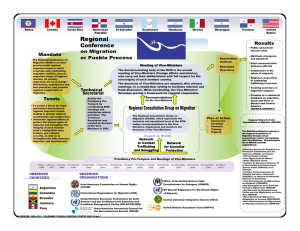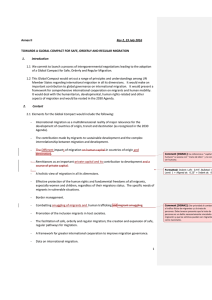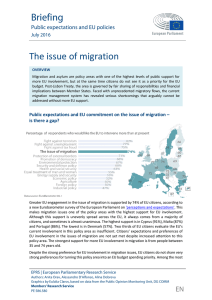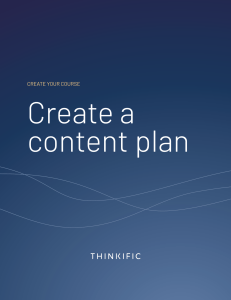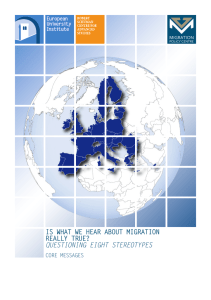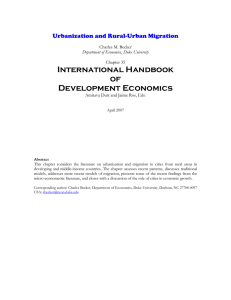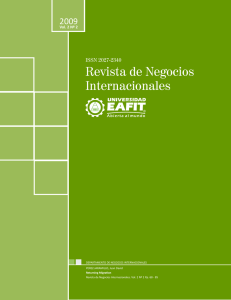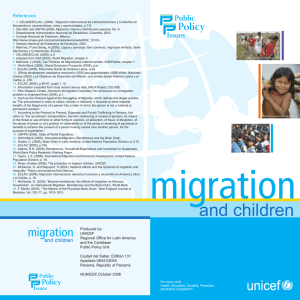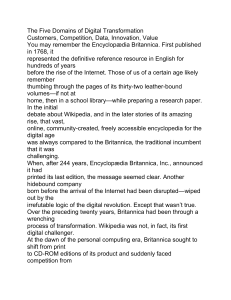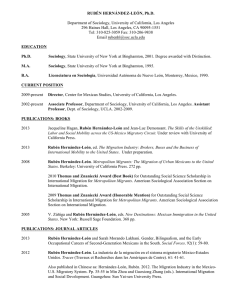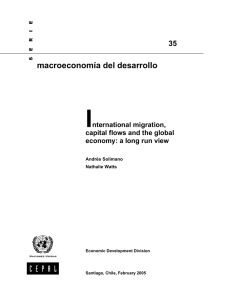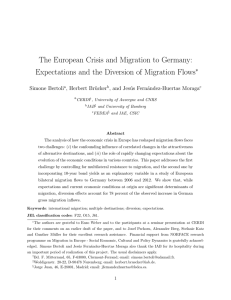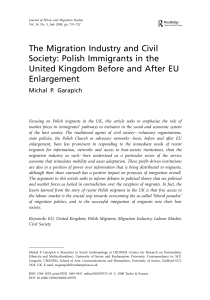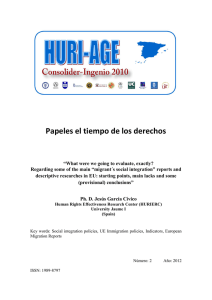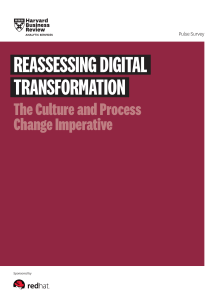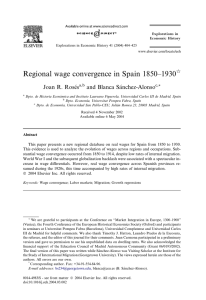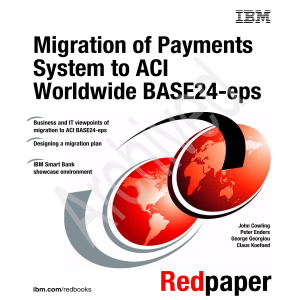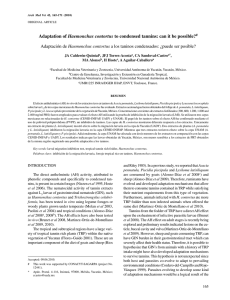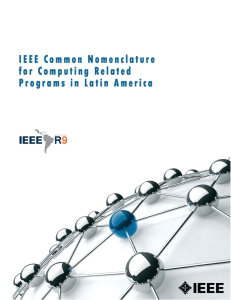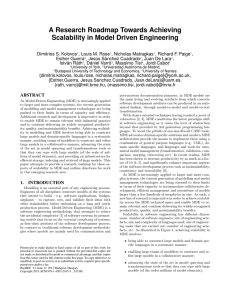Organizational Design As A Competitive Advantage In The Digital Era
Anuncio
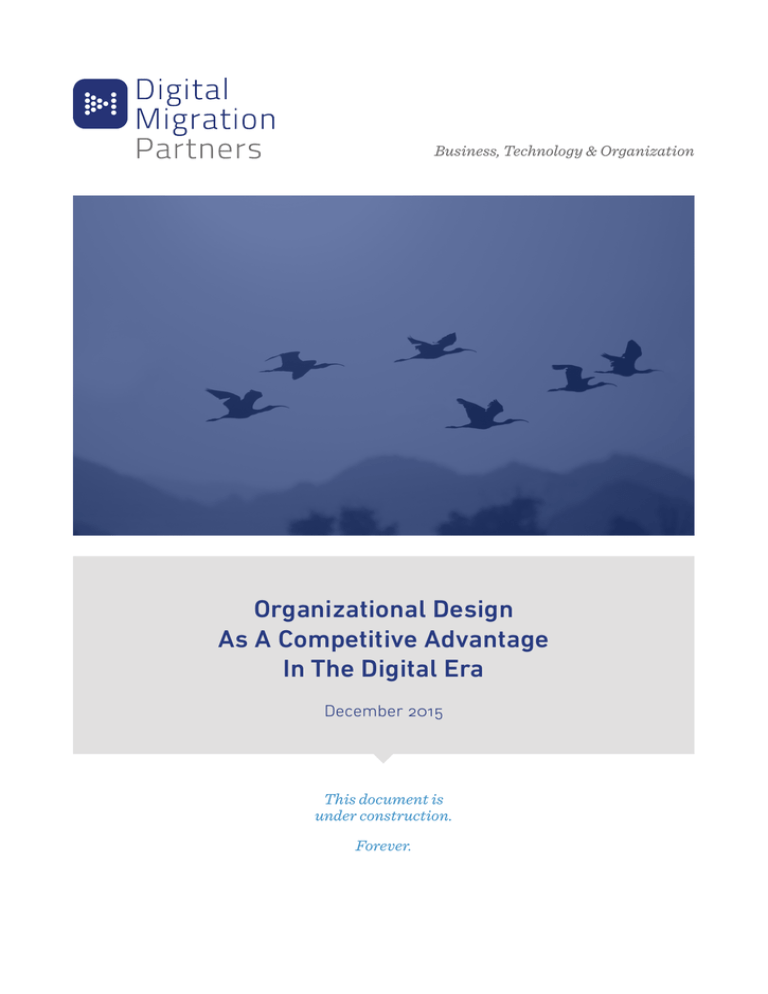
Business, Technology & Organization Organizational Design As A Competitive Advantage In The Digital Era December 2015 This document is under construction. Forever. Index 01 Problem Definition: The Challenge............................................................................ 3 02 Background................................................................................................................... 5 03 High Level Solution Overview.................................................................................... 7 04 Solution Details............................................................................................................8 Stage 1 Anchoring the Basics....................................................................................9 Stage 2 Feeding the System.................................................................................... 10 Stage 3 Delivering High Performance.................................................................... 11 Sustainability of Our Ecosystem............................................................................. 12 05 Fast Track to Organizational Design...................................................................... 13 06 How Can We Help You............................................................................................... 14 Digital Migration Partners 2 01 Problem Definition: The Challenge “Digital transformation is more of a management challenge than a technology one“ Focusing only on technology is a short sighted perspective that delivers frustration when implementing digital changes in an industrial shaped structure. the efficiency of the organizational design. Essential characteristics of the digital era are not grasped in a top-down linear design. Empowerment vs hierarchy, capabilities vs job descriptions are key currencies in so called digital corporations. The model is broken. Empowerment Vs. Hierarchy Certainly technology and digital tools are at the center of most evolution shifts in customer experience. Without any regard the implementation of digital platforms is a basic requirement in winning in the market strategies. However we tend to overshadow the fact that at the end of the day digital transformation happens, or not, at an organizational level. So to say, since organizations are wired to deliver on a business model, if that business model changes so does the organizational design. But does this happen? Unfortunately the answer is no. Organizational design from the industrial Era Most companies tend to inherit an organizational chart that was well designed on delivering versus past challenges. The institutional approach, that is taking a classic design for granted, shadows the reality of an organization shaped for the industrial era where Standard Operating Processes (SOP), represented as boxes, where perfectly engineered to cope with opportunities as well as challenges in an ultra efficient manner. Nevertheless as we acknowledge that mass production, scale and predictability fade nowadays, so does Digital Migration Partners Organizational design is the new competitive advantage. In a stiff though successful industrial model, wiring a new way of working made little incremental changes. As globalization spread across the late nineties, matrix reporting and cross border business units arouse in competing industries as a subtle novelty, but again established themselves as the next business commodity, replicated all over the world. We believe the right approach to Digital Transformation starts by assessing how technology impacts (disintermediates) the company’s value chain. Understanding the starting point leads to shaping the right strategy and measuring progress through the proper KPIs. However success is achieved only at an organizational level. There lies the importance of organizational design. 3 Organizational design according to Digital Migration Partners aims at answering three basic questions in order to operate efficiently in the new digital era: How to work How to organize How to lead We believe in organizations that are created to last for a very long time. As James P. Carse states there are two kind of games: “One could be called finite; the other infinite. Finite games are the familiar contests of everyday life, they are played in order to be won, which is when they end. But infinite games are more mysterious. Their object is not winning, but ensuring the continuation of play. The rules may change, the boundaries may change, even participants may change – as long as the game is never allowed to an end” We intend through this well thought and documented piece of analysis, not to write an academic paper, but to set the foundations for a new methodology aiming at guiding companies through this phase of the digital transformation process.We are keen on supporting our ideas and recommendations on academic papers as well as relevant literature back from the early seventies all the way through nowadays but digging deep into scientific content as well. And of course based on our own experience and criteria. “Digital era is opening the opportunity of setting the company’s organizational design as a sustainable competitive advantage, just as pricing, product quality or customer service“. ©Sinpalabras Digital Transformation Digital Migration Partners 01_Problem Definition: The Challenge | 4 02 Background “Organizational designing, conceived as the shaping of organizational forms and ways of working, is an important issue in management thought and practice. Designing and redesigning organizations is a core activity of managers which is significantly gaining strategic importance overtime.“ The so called digital transformation refers to the changes associated with the application of digital technology in all aspects of managing an organization as well as the fast habits changes adopted by customers. Following early digital transformation experts Lankshear and Knobel (2008), we can acknowledge that individuals and organizations go through a literacy process that progressively builds an effective utilization of digital capabilities and its consequences. Specifically, they transition three key stages. Digital Competence The foundation of the system is established, spanning a wide range of topics and also encompassing a differentiation of skill levels from basic visual recognition to more critical, evaluative and conceptual approaches. Digital Usage There is an informed use of digital competencies across different business situations. It involves utilizing digital tools to seek, find and process information and then developing a solution addressing the task or problem. Reaching the latter stage means that the organization is able to inherently manage business issues, in a particular domain, through different levels of innovation, rather than simply enhance and support the traditional methods. To consolidate an efficient digital platform, organizational changes have to encompass technology progress. Arguably, one cannot work without the other. In the scientific literature and the professional about organizational designing, three different perspectives on the process of designing have been developed: a rational, a dialogical, and a pragmatic (Visscher y Visscher-Voerman, 2010). Within the rational approach, organizational designing is seen as the construction of blueprints for the structural characteristics of organizations. Traditionally, these structural characteristics concerned the formal structure of the organization (i.e. the division of labor into functions, the allocation of tasks, responsibilities, and authority of these functions, and the creation of hierarchical and lateral mechanisms to coordinate and integrate them) (Mintzberg, 1979; Harris and Raviv, 2002). The dialogical approach conceives organizations as political systems; structures are supposed to serve the interests of the people who have the power over the resources on which the organization is most dependent (Hickson et al., 1971; Pfeffer, 1981; Mintzberg, 1983). Designing is primarily a process of building consensus or compromises about an organizational form within a certain dominant coalition and its decision making process. In such a process, it may happen that not the entire problem and solution space is explored, as the spaces that are incompatible with the interests of the dominant coalition are shut off. Digital Transformation Lastly, the pragmatic approach tries to absorb complexity whilst the other two just reject it. Digital usages that have been developed enable innovation and creativity and stimulate significant changes within the work environment. The assumption of this framework is that design situations have a complex nature (Rittel, 1972; Rittel y Webber, 1973), which means that they are unique, Digital Migration Partners 5 ambiguous, and difficult to define unequivocally. They also embrace more than only the structural characteristics of the organization. In our business practice, over the last five years, we have dealt with digitalization issues that fit in different organizational frameworks. There is a variety of additional taxonomies regarding decision-making processes (organizational analysis). We are keen to apply some of them in order to fully grasp the organizational culture and therefore adjust our assessment and actions accordingly (Organized anarchies, Rational actors, Resource dependence, etc). The rational, dialogical and pragmatic approaches of Digital Migration Partners the design process have different views of the object and the process of designing, and emphasize different aspects of the design process as crucial. However, our core insight is that only a well designed organization with all the design elements working a coordinated fashion is able to accomplish a sound transformation. While technology has been impacting the value chain of numerous businesses through disintermediation, managers and teams who have neglected the organizational changes that should encompass technological shifts have usually failed. Our aim is to help organizations device the right planks to reach the digital transformation stage, effectively and with minimal disruptions, so that business objectives are met. 02_Background | 6 03 High Level Solution Overview The digital revolution has reached a preeminent role in the process of building high performing organizations. “Digitalization has become pervasive and represents a compulsory process that decisively contributes to guarantee the survival of any organization in the marketplace“ Those organizations, across virtually any sector of the economic activity, which do not successfully adopt the new business paradigm will significantly diminish their efficiency and learning capacity, languishing and eventually perishing. All the capabilities arising from the new digital ecosystem help, therefore, organizations and individuals to become more efficient and competitive and can be considered a compelling business driver. Interestingly, technology constitutes the main carrier that facilitates the change, however, digital migration cannot be properly accomplished and completed unless companies build the right organizational platform. There is more and more evidence, based on corporate experience as well as academic research, showing Digital Migration Partners that technological advances, by themselves, are not sufficient to generate a sound transition. The so called digital migration is a complex product coming out of the deployment of the latest technology combined with key organizational variables. It entails determining a sound organizational strategy, devising the right structure and set of processes to support it, establishing the appropriate competencies system, allocating meaningful positions and hiring the right individuals for them whilst providing accurate incentives to elicit desired behaviors. In a highly dynamic marketplace only highly flexible structures will prevail. In our experience, most companies tend to keep their focus on sheer technology to substantiate the digital migration process. They often either neglect or give a secondary role to those organizational and psychosocial variables which eventually contribute to the success of most corporate initiatives. Among these variables but not limited to, we could mention speed, transparency, autonomy, efficiency and commitment that act as main principles of action. In essence, what is needed is to approach and manage those deep changes triggered by the new digital technologies, in the workplace, applying scientific behavioral theories and principles to make organizations more efficient and high performing. 7 04 Solution Details “The proliferation and adoption of digital technologies by organizations is not enough to guarantee success“ Inspired by the scientist-practitioner model, our business practice relies on two core tenets. The first one assumes that successful businesses are basically supported by healthy and meaningful organizations. The second implies that technology is a critical business component whose efficiency and applicability is mostly dictated by the way the organization is designed. Digital Migration Partners As such, companies need an organizational framework consisting of a set of configuring structures, processes, reward systems and people practices that create an effective behavioral scheme capable of achieving the business strategy and the objectives related to it. Digitalization has deeply affected the organizational architecture and, therefore, its design. The organization is not merely an end in itself but a vehicle for accomplishing the strategic tasks of the business. Thus, we must conclude that by deliberately managing and controlling organizational design policies and processes we can effectively influence employee behavior within this new digital environment. 8 STAGE 1 ANCHORING THE BASICS Over this preliminary phase, companies try to establish the foundational elements that help build a meaningful transition from a classical to a highly digitalized organizational environment. This process usually does not start from scratch as virtually all organizations have, by default, design elements in place and most of them can be considered functional and well integrated. Otherwise, the organization, as such, would have collapsed unable to reach their objectives. We, at DMP, try to leverage on those healthy prominent elements to facilitate the digital consolidation whilst correcting the weaknesses shown in other organizational areas of the business. (Examples: managers, departments that do not need to move so fast, processes). Based on our own professional experience as well as the most updated academic and scientific research (further explain our 5 sources of knowledge), we have defined five initial organizational dimensions that companies have to develop and link. They are dynamic and continuously evolving; they overlap, and impact each other but have to be worked out rather separately to enhance the organizational efficiency. Understanding and shaping the Organizational Culture No organizational change can be successfully accomplished without framing it in the so called organizational culture. This concept can be described as a set of values, beliefs and assumptions shared by the individuals, within an organization, that directs interpretation and action by defining appropriate behavior for various situations. The organizational culture has been shown to have an impact on important organizational outcomes, among them change and adaptation to new situations. Defining the right Mission / Purpose and developing a suitable identity are cornerstones to this phase. Building and enforcing the System of Competencies To support those critical organizational dimensions we have described, companies need to build a framework of capabilities that individuals must possess. We call this a competency model. This organizational plank is typically built around a set of behavioral dimensions that constitutes the basis for both job efficiency and professional development. They set the standards for how people should behave within the organization to accomplish the objectives. Competencies offer at least three critical benefits: clarity, as they set clear expectations about the values and behaviors individuals have to show; consistency, as they provide an integrated and shared framework and language to develop and execute the corporate strategies and, lastly, connectivity as they bring core metrics for many of the human resources processes. In this context, digitalization has brought the need to qualify and deploy a new set of individual competencies that, eventually, guarantee the survival of the organization. Those worn-out sets of competencies, that inspired job performance in the past, have to be replaced. On the one hand a new generation of core capabilities are developed across the market while on the other hand a set of advanced ones related to the particular industry need to be addressed. Educating and Training individuals The systematic acquisition of skills, concepts as well as attitudes that results in improved performance has become critical in the digital environment. A significant percentage of people holding managerial as well routine roles are part of what we have coined as digital natives; they are not fully versed in all the digital tasks required to perform the job effectively. Our professional experience indicates that training those individuals in digital capabilities pays off in terms of higher net sales and gross profitability per employee. Training is highly beneficial for the organization and for employees to increasing their value to their organization. Moreover, even those individuals we know as digital natives need Digital Migration Partners an ongoing training update due to the deep and fast market changes technology delivers. However training in digital skills only is a limited vision for the talent development. As succeeding in the digital era requires a new set of capabilities (core and advanced) such as autonomy or sharing knowledge, these matters can and must be taught. Learning by doing with the properly designed processes delivers clear progress when building capabilities. We have witnessed that many organizations are using training and development more often as a way to attract and retain their most successful employees. 04_Solution Details | 9 Establishing a sound Flow of Communication and Decision Making Digital transformation goes straight to the core of communication and decision-making. Although these two dimensions do not reflect the same reality they overlap and can be considered complementary sides across any organization. As such, technological advances make both interpersonal contact and problem-solving activities more agile and robust. Interconnectivity opens a completely new way of finding solutions deemed to be satisfactory to accomplish organizational objectives. Therefore the usage of well fitted digital tools aimed at sharing data, knowledge or project management are essential to fast adapting teams. Slack, Trello, Geckoboard, Evernote or Box among others are good examples. Conceiving and deploying the right Organizational Structure The way activities are directed towards the achievement of the organizational objectives and goals embodies what we know as organizational structure. It allows the allocation of responsibilities for different functions and processes to different entities (i.e. branch, department, work-group, individual). Following this approach, an organization can be structured in many different ways, depending on their objectives. Thus, the structure will determine the modes in which it operates and performs. Digitalization is dramatically changing the foundation on which standard operating procedures rest. Therefore, organizations exposed to the new business paradigm usually need to reengineer their structure. Releasing organizations from redundant hierarchy prior focused on brokering information tends to be an early approach. Articulating more flexible ways of organizing in order to deliver at market speed translates in fast adapting companies into project lead organizations vs department bias. STAGE 2 FEEDING THE SYSTEM Once the foundational elements have been set up, the organization needs to go one step forward by fulfilling and enhancing some systemic processes that will foster the digitalization effort. Usually, this stage entails significant changes that will deepen all those digital capabilities that need to emerge to gradually overcome the components of the classic business model. Introducing a Talent Recruitment policy As long as the set of competencies to soundly perform a job varies, the organizations need to adapt their recruitment practices to the new environment. The way to reach suitable candidates as well as the selection policies and tools have significantly changed and need to be fluently managed by practitioners. We recommend new ways of identifying and choosing the right candidates to cover those positions built on a new set of competencies. Building a Rewards’ System People with different professional and personal profiles, within a different work environment, will not respond the same way to traditional rewards. To elicit and maintain new desired behaviors, both extrinsic and intrinsic reinforcements will need to be in place. It’s been explicitly proven that some of the traditional rewards delivered in the classic organizational setting not only are ineffective but also end up damaging the work dynamics. It is important to build new reward systems that align the goals of the employee with the goals, namely policies regulating salaries, promotions, bonuses, profit sharing, stock-options, and so forth. Conducting a constructive Performance Appraisal Evaluation on performance substantially changes within the digital environment. The process of measuring individuals or groups work behaviors and outcomes against the expectations of the job follow different patterns. Performance appraisal conceived as a tool frequently used in promotion and compensation decisions has to be reengineered in the light of the new job demands and competencies system. We are fully aware of the importance of appropriately conducting a new generation of performance appraisals. As shown in multiple ambits, it not only boosts employee’s moral but also acts as a retention tool avoiding regretted turnover. Strengthening Positive Leadership and managing Power & Politics Organizational leadership is not a static trait exclusively related to the role of the so called leader. In digital organizations, we have witnessed the prevalence of a leadership model that incorporates four interacting variables, leader, followers, time and situation, whose dynamics model the culture of the organization and its sustained growth performance. In a context of quick flows of information, higher transparency and more visible power agendas. Understanding Power & Politics Digital Migration Partners at the company is essential to craft the proper approach when transforming the organization. One size solution does not fit all companies. It is most recommended to transition from a transactional leadership model to a transformational one in which behavioral principles such as selfawareness, internalized ethics, balanced information processing and transparent social relationships shape the behaviors of both leaders and followers. 04_Solution Details | 10 STAGE 3 DELIVERING HIGH PERFORMANCE The last stage of our process entails building a highperformance digital organization. To do so, we will need to accomplish a series of steps which have been outlined before. In a nutshell, these type of organizations will have a specific and well defined design, integrated by people holding a set of talents and skills, aligned with and committed to a common purpose, who consistently show high levels of collaboration and innovation that produce superior results. Additionally, leadership is not vested into a single individual but taken up by various members, according to the need at that time. Lastly, these type of organizations have robust methods of resolving conflict efficiently, so it does not become a roadblock to achieving the team’s goals. All in all, the high-performance digital organization is regarded as an entity that fully exploits digital capabilities so that it can achieve its goals. Efficiency, Transparency, Commitment, Speed, Autonomy seem to be killer concepts to this objective. Reinforcing Job Satisfaction & Engagement Job satisfaction reflects an employee’s overall assessment of their job, particularly their emotions, behaviors, and attitudes about their work experience. This variable has strong a practical utility for those organizations which are planning or executing a transition towards a digital ecosystem. As such, job satisfaction is tightly linked to critical job outcomes like performance, absenteeism or employee turnover. Going one step further, work engagement is defined as a positive, fulfilling, work-related state of mind that is characterized by vigor, dedication, and absorption. In essence, work engagement captures how employees experience their work. As far as research and our own practical experience has revealed, engaged employees are highly energetic, self- efficacious and they exercise influence over events that affect their lives and over others. Engagement is related to bottom line outcomes such as job performance, client satisfaction and financial returns. Scheduling a sound Career Development Organizations, especially those immerse in a transition process, need to manage the career progress of their members and their success at each stage of development. In an environment characterized by constant and pervasive technological and organizational change, companies have to define and manage work transitions to move individuals towards reaching business goals. As hierarchy fades new ways of rewarding need to be designed and applied. While salary and benefits will prevail along the way under different forms, new KPIs will be adopted by employees to show off satisfaction and inner success. Stimulating positive Group Dynamics and Social Networking Organizations are integrated by individuals but also by groups, formal and informal. The interaction between individuals of a collective and the processes involved such as forming opinions and attitudes, establishing feedback loops and adaptations have a big impact in the functioning of an organization. In our professional practice we have experienced how relevant team dynamics, social networks and social brokers (R.Burt), favoring those interactions, are for the performance of an organization. Organizations support the use of teams, because teams can accomplish a greater amount of work than isolated individual contributors and because the collective results of a group can produce higher quality deliverables. Expanding Occupational Health and Wellbeing Fostering a culture of wellbeing shows strong links to important organizational outcomes, such as productivity, physical and psychological health, and employee retention. These positive changes in individual wellbeing and employee engagement help feed further improvements in wellbeing and engagement, completing a healthy organizational Digital Migration Partners cycle. Enhancing the profile of organizational health and psychological well-being, in its widest sense (workplace design, healthy food, extended vacation, flexible work hours), contributes to significantly raise personal effectiveness and, therefore, positively affects multiple business performance parameters. 04_Solution Details | 11 SUSTAINABILITY OF OUR ECOSYSTEM “The process of moving towards a consistent digital framework has to be developed so that it permeates all the organizational design elements and is able to become a substantial part of it“ Embedding digital design into your organization will create a competitive advantage. We have shown, in detail, how to accomplish a meaningful and seamless digital transformation from an organizational point of view. As long as your organizational architecture is designed to make it sustainable, it will greatly contribute to the financial success of your company. According to us the ultimate KPI for digital transformation is no other than cash flow. The empirical evidence, however, demonstrates that just a selected group of organizations are taking steps to embed sustainability into their core business practices. As far as professional practice and different lines of research have established (footnote), achieving a functionally sustainable ecosystem is a product of three variables we can help you control in the transition process and afterwards: Company’s purpose, mission and value statements Digitalization represents a new business paradigm. As such, the need to integrate digital axioms into the company’s purpose, mission and value statements emerges as a need. Relatedly, we have to emphasize the organizational principle that while it is necessary for companies to develop their organizational organic principles, simply having them isn’t sufficient. They should come to fruition and become evident, more than ever, since digitalization introduces new rules, like transparency and connectivity, which make more evident the need to strongly internalize them. Based on the new business paradigm, inconsistency usually delivers undesired outcomes. Strategic management of stakeholders The strategic management of stakeholders has become critical for the success of virtually any business. Companies do best by incorporating the full range of stakeholders into the development and implementation of the company’s core values and mission in pursuit of the vision. The new model assumes a broad concept of stakeholder, establishing that they all hold full accountability in the process of generating profit for the organization and making possible its continuity in the marketplace. Digitalization provides a framework that makes necessary for all stakeholders to engage into it; be they investors, customers, employees, suppliers or even communities or governmental associations. People, Processes & Structure Lastly, the different organizational design elements result essential to changing the culture of a company. We recognize that the true value of sustainability is realized only when it is embedded into an organization’s culture. Within the digital environment, the ability to identify opportunities and innovate new processes not only requires that every stakeholder understands sustainability and Digital Migration Partners practices it. There is also a compelling need that the key components of the organization leverage and sustain the change. To move forward we take among others the five elements developed by Professor Jay Galbraith (i.e. Strategy, Structure, Processes, People and Rewards) and work on them to facilitate the transition and maintain the changes. 04_Solution Details | 12 05 Fast Track to Organizational Design We recommend companies to establish the policies and tools with which their management must become skilled in order to shape the decisions and behaviors of their organizations. As stated, organizations that are intrinsically dysfunctional and ill-conceived will hardly deliver an Digital Migration Partners optimized performance regardless of their level of digitalization. On the other hand, those companies with solid organizational fundamentals will easier and quicker assimilate the transition process by optimizing their resources both human and financial. Following this criteria, we have engineered this process in three basic stages built around thirteen core dimensions. 13 06 How Can We Help You We assist your organization to device and bring into fruition the right design that will establish the foundation to make that transition actionable. We do it by combining a combination of different perspectives that have both, a strong business as well as an academic and/or scientific support. In other words, we answer the three fundamental questions: How to work How to organize How to lead 1 We analyze in-depth the structural configuration of the organizations. We have developed a model to interpret different organizational cultures applying different frameworks based on academics, benchmarking and our business experience. This first stage allows to adapt recommendations. 2 We analyze the leadership patterns. We do it from a multi level perspective (key individuals, teams, departments) to assess the potential gap vs. a transformational leadership. 3 We define the right Capabilities (not just technical skills) that are needed to win in the industry. We have been especially active on this area of intervention responding to an increasing demand in the marketplace. Those worn-out sets of competencies, that inspired job performance in the past, have to be replaced by a new generation of capabilities Digital Migration Partners that we have defined based on our researched and professional practice. 4 We have developed top-notch training programs that address digital organizational needs across different sectors and functional business areas. Not surprisingly, we have witnessed that many organizations are using training and development as a way to attract and retain their most successful employees. 5 We develop and implement team effectiveness programs so that the organizations can assemble in a more effective way their human resources to reach their goals, particularly in digital environments and situations of transition. 6 We help you conceive, implement and track this process to maintain long-term those digital capabilities and endure up to the point that they become an intrinsic part of your every-day operations. We at Digital Migration Partners work in a seamless way as we deliver on weekly basis, move along side by side with our customers applying different methodologies and frameworks. We believe in transparent and efficient communication. We structure our commitment not surprisingly in three phases (How to work, How to organize and How to lead) and we finish our organizational design in no more than twelve weeks. Let us know if we can help you. Alberto Díaz Javier Blanch 14 References James P. Carse (1985), Finite and Infinite Games, a vision of life as play and possibility Harris, M. and Raviv, A. (2002), “Organization design”, Management Science, Vol. 48 No. 7, pp. 852-65. Hickson, D.J., Hinings, C.R., Lee, C.A., Schneck, R.E. and Pennings, J.M. (1971), “A strategic contingencies’ theory of intra organizational power”, Administrative Science Quarterly, Vol. 16 No. 2, pp. 216-29. Lankshear, C., & Knobel, M. (2008). Digital literacies: Concepts, policies and practices (Vol. 30). Peter Lang. Mintzberg, H. (1979), The Structuring of Organizations, Prentice-Hall, Englewood Cliffs, NJ. Frederic Laloux (2014), Reinventing organizations, A guide to creating organizations inspired by the next stage of human consciousness Mintzberg, H. (1983), Power In and Around Organizations, Prentice-Hall, Englewood Cliffs, NJ. Amy C. Edmondson (2012), Teaming, how organizations learn, innovate and compete in the Knowledge economy Pfeffer, J. (1978), Organizational Design, AHM Publishing, Arlington Heights, IL. Brian J. Robertson (2015), Holacracy, the new management system for rapidly changing the world Rittel, H.W.J. (1972), “On the planning crisis: systems analysis of the first and second generation”, Bedrifts Okonomen, Vol. 8, pp. 309-96. Nathan Furr and Jeff Dyer (2014), The innovator’s method, bringing the lean start up into your organization Rittel, H.W.J. and Webber, M.M. (1973), “Dilemmas in a general theory of planning”, Policy Sciences, Vol. 4, pp. 155-69. Eric Schmidt & Jonathan Rosenberg (2014), How Google works Salim Ismail (2014), Exponential organizations, why new organizations are ten times better, faster, and cheaper than yours Digital Migration Partners Visscher, K., & Visscher-Voerman, J. (2010). Organizational design approaches in management consulting. Management Decision, 48(5), 713-731. Ahn, M. J. y Ettner, L. W. (2014). Are leadership values different across generations? A comparative leadership analysis of CEOs v. MBAs 0. Journal of Management Development, 33(10), 977-990. Antino, M., Gil-Rodríguez, F., Rodríguez-Muñoz, A., Borzillo, S. y Black, M. (2014). Evaluating positive leadership: Pilot study on the psychometric properties of a reduced version of the positive leadership assessment scale. Revista de Psicología Social, 29(3), 589-608. Avolio, B. J., Luthans, F. y Walumbwa, F. O. (2004). Authentic leadership: Theory building for veritable sustained performance. Lincoln: The Gallup Leadership Institute. Bono, J.E. y Judge, T.A. (2004). Personality and transformational and transactional leadership: A metaanalysis. Journal of Applied Psychology, 89, 901-910. Cameron, K. S. (2012). Positive leadership: Strategies for extraordinary performance. San Francisco, CA: Berrett-Koehler Publishers. Cameron, K. (2013). Practicing positive leadership: Tools and techniques that create extraordinary results. Berrett-Koehler Publishers. Cameron, K. y Plews, E. (2012). Positive leadership in action: Applications of POS by Jim Mallozzi, CEO, prudential real estate and relocation. Organizational Dynamics, 41(2), 99-105. Donaldson, S. I. y Ko, I. (2010). Positive organizational psychology, behavior, and scholarship: A review of the emerging literature and evidence base. Journal of Positive Psychology: Dedicated to Furthering Research and Promoting Good Practice, 5, 177-191. Elshout, R., Scherp, E. y van, d. F. (2013). Understanding the link between leadership style, employee satisfaction, and absenteeism: A mixed methods design study in a mental health care institution. Neuropsychiatric Disease and Treatment, 9 15 Keevy, Z. y Perumal, J. (2014). Promoting transformational leadership practices of retail managers. Journal of Management Development. Kelloway, E.K., Weigand, H. McKee, M.C. y Das, H. (2013). Positive Leadership and Employee Well-Being. Journal of Leadership & Organizational Studies, 20(1), 107-117. Nielsen, K., Randall, R. y Christensen, K. B. (2010). Does training managers enhance the effects of implementing team-working? A longitudinal, mixed methods field study. Human Relations, 63(11), 1719-1741. Schynsa, B. y Schilling, J. (2014). How bad are the effects of bad leaders? A meta- analysis of destructive leadership and its outcomes. The Leadership Quarterly, 24(1), 138–158. Searle, T.P. y Barbuto, J.E., Jr. (2013) A Multilevel Framework: Expanding and Bridging Micro and Macro Levels of Positive Behavior With Leadership. Journal of Leadership and Organizational Studies, XX(X) 1 –13. Senge, P. M. (2014). The dance of change: The challenges to sustaining momentum in a learning organization. Crown Business. Parris, D. L. y Peachey, J. W. (2013). A systematic literature review of servant leadership theory in organizational contexts. Journal of Business Ethics, 113(3), Tafvelin, S., Armelius, K. y Westerberg, K. (2011). Toward understanding the direct and indirect effects of transformational leadership on well-being: A longitudinal Reid,Wilbur A., I.,II, West, G. R. B., Winston, B. E. y Wood, J. (2014). An instrument to measure level 5 leadership. Journal of Leadership Studies, 8(1), 17-32. Youssef-Morgan, C.M. y Luthans, F. (2013). Positive leadership: Meaning and application across cultures. Organizational Dynamics, 42, 198-208. Digital Migration Partners References | 16 Contact www.digitalmpartners.com @digmigpartners +34 91 192 40 57 Madrid C/ San Lorenzo 11 C.P. 28004 Barcelona C/ Diputació 37 C.P. 08014 For more information [email protected] Copyright © 2015 Digital Migration Partners S.L.
